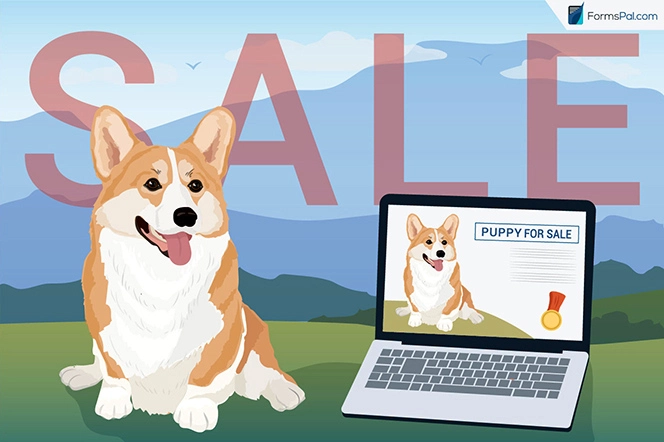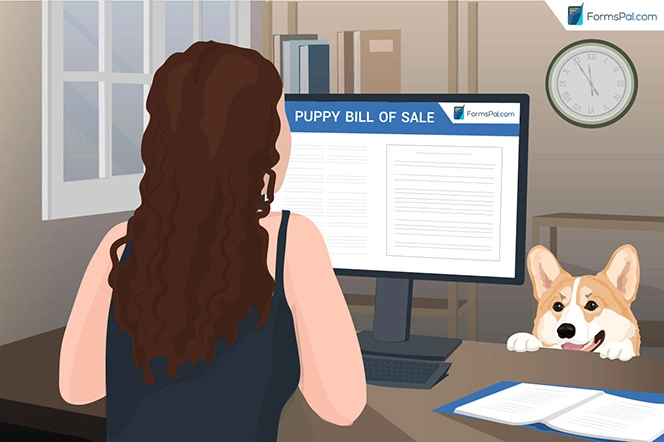Dog (Puppy) Bill of Sale Form
The puppy bill of sale is a legal agreement that involves the breeder or dog owner and the purchaser. It acts as proof that the deal took place since it has the names of both parties, signatures, and the date of the sale.
It is beneficial to both the seller and buyer since a puppy bill of sale guarantees you with legal records of the transaction. The contract protects the rights of both parties while ensuring that you do not engage in illegal transactions. However, your puppy must be 8 weeks old and above to be put up for sale. This is a legal requirement in most states. If you want to purchase a dog or a puppy, ensure that you request the seller to produce a dog or puppy bill of sale.
Our comprehensive article gives you more insight into a dog bill of sale, why you need to use it, and its details. You will also know whether you require signatures on puppy contracts or not plus other crucial information.
Why Use a Puppy Bill of Sale
Dog owners or breeders have numerous reasons why they want to sell the animal. Maybe you don’t want to take care of the dog or you are expecting other puppies as a breeder. For this reason, you need to have a dog or puppy bill of sale form in case you want to sell a dog or puppy.
Buyers and sellers need to sign a puppy contract before completing the sale transaction. It secures the interests of both parties by ensuring that the deal is transparent. Due to numerous cash transactions that customers prefer to use, it might be challenging to confirm the sale’s details without proper documentation.
The agreement reveals the evidence of payment from the customer, any pending amount, and the terms of paying it within the stipulated timeframe. The purchaser has to sign and accept liability for paying the amount within an agreed timeline.
For the puppy or dog buyer, it acts as a cushion of proof of the legal transfer of ownership. In case anything happens to the dog after signing the bill of sale and paying, the new owner will be liable.
Dog Bill of Sale Form Details
| Document Name | Dog Bill of Sale Form |
| Other Names | Puppy Bill of Sale, Pet Bill of Sale |
| Avg. Time to Fill Out | 8 minutes |
| # of Fillable Fields | 58 |
| Available Formats | Adobe PDF; Microsoft Word |
Why Is a Puppy Bill of Sale Important?
The dog or puppy bill of sale is a binding agreement with details of the terms of the sale of the puppy. It is a contract that provides evidence of the sale and indicates the new dog owner.
Below are some of the reasons why it is important to use a dog bill during a sale:
- It prevents any misunderstanding after the deal is complete.
- The form acts as evidence of ownership.
- It provides accurate information about the puppy.
- It guards the seller against illegal business deals.
Can I Get a Dog Bill of Sale Online?
Since drafting a dog bill of sale form may be quite challenging with all the legalese, you can access a bill of sale template online. They are convenient and readily available as long as you have a computer, laptop, or smartphone plus a stable internet connection.
Access our site and get a downloadable bill of sale forms accepted by the state. Fill in the name, address, breed, color, cost, and other relevant details on the order form. It is available in editable formats such as Word, PDF, and ODT. Whether you are a breeder or dog owner, you can customize the bill of sale to suit your sale needs. They are high-quality forms with the legal language already in place, so there’s no need to stress about the complicated jargon.

Other Bill of Sale Forms for Animals
How Do I Sell a Puppy or a Dog?
Need to sell or purchase a dog or a puppy with no idea of where to start? Follow our guidelines below:
Step 1: Advertise Your Puppy or Dog

It is imperative to put up your puppy ad early enough before the sale, especially if your other dogs are expecting puppies. It gives your puppy a higher chance of finding the right home quickly. Ensure that you have all of the essential documents of the dog within reach that can certify all of the information. Include details such as date of vaccines, breed, and other relevant information.
Identify the method of advertising such as newspapers, flyers, or online resources. When it comes to pricing, ensure that you carry out due diligence to find a reasonable purchase price that will not scare potential buyers.
Step 2: Meet the Potential Buyer

When you get a prospective buyer, you need to meet up and ensure that your dog will have a good home. Do not hesitate to ask questions relating to previous ownership, the reason for purchasing a puppy, the neighborhood, and maintenance standards.
Step 3: Fill Out the Puppy Bill of Sale

You can download and print a free sale form for a dog or a puppy on our site instead of writing one from scratch. Here are the details of the sale form that you have to fill in:
- Date of the puppy sale
- Full name of the buyer and physical address
- Full name of the customer and physical address
- Cost of the dog or puppy
- Information about the dog, i.e., name, breed, sex, date of birth, color, health condition, and registration number
- Mode of payment and deposits (if any)
- Guarantees (if any)
- Dates, signatures, and full names of the seller, customer, and witnesses
Step 4: Get Confirmation by a Public Notary

After filling out the bill of sale, ensure that you approach a member of the public notary to acknowledge the agreement by stamping and issuing you with an acknowledgment certificate. It is the final step that seals the transaction. The seller will then issue a receipt to the new dog owner to show that payment is complete.
How to write a Puppy Bill of Sale?
Down below, you will see the guidelines developed by using the dog bill of sale template developed by our experts. Yet, if there’s a form supplied by your local authorities, it’s advised to choose it in the deal.
Step 1: Indicate the bill of sale creation date.

Step 2: Enter the details of each party (purchaser and seller):
- Name
- Address: Street, City, State of residence, Area code
- Contact information: Telephone number, Email address

Step 3: Specify some details pertaining to the dog or puppy that is being sold:
- Name (if applicable)
- Breed (if known)
- Sex
- Date of birth
- Registration number
- Color
- Health condition

Step 4: Pick the way the purchaser will pay for the dog or puppy and for how much.
Type in the purchase date and state the entire amount that must be paid for the animal. As soon as that’s been concluded, you will need to mark the way of purchase:
- One-time payment. Nothing difficult here: the buyer pays the full sum in one payment and has the dog or puppy transported to them within the same day.
- In installment payments. Indicate the downpayment amount plus the exact date when it must be paid, along with the date by which the full amount must be handed to the dog owner.
And after that, indicate how the buyer is going to pay:
- Cash
- Cheque
- Cashier’s check
- Money order

Step 5: Review the miscellaneous provisions.
The “as-is” paragraph points out that the dog or puppy owner gives no warranties and is not liable for the health condition of the animal after the sale.

Step 6: Place your signature(s) in the corresponding fields.
The buyer’s signature is generally not needed. But, it is advised to get the form signed by each party. You can also have one or several witnesses attest the deal.

Step 7: Have a notary public attest the form
Although notarization is almost never mandatory, it functions as one more way to safeguard against legal problems. It would also be wise for both parties to keep a dog bill of sale in their records.


